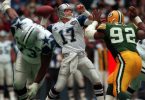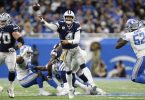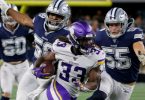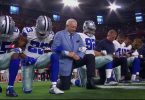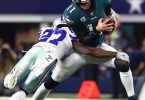The dark days of autumn in 1984 are hazy now, but the memories came flooding back Thursday with the news that Cowboys star center Travis Frederick has contracted the heinous disease called Guillain Barre’ Syndrome.
Thirty-four years later, those words still send a chill down my spine. It’s the disease that killed my father. He was only 61 years old.
This is not to say that Frederick is necessarily in mortal danger. According to the Mayo Clinic website, the disease is rarely fatal, though it lists no numbers on that likelihood now. Once doctors had made a final diagnosis on my dad back in the late summer of 1984, I rushed to the downtown Arlington library – no internet back then – to breathlessly read that 9 out of 10 patients of Guillain Barre’ survive.
Knowing my dad and those numbers, I naively figured he’d fight through it, just as he had Pearl Harbor, Guadalcanal, Midway and other historic South Pacific battles as a decorated U.S. Marine in WW II. After all, he’d twice survived being wounded when his torpedo bomber was shot down. Twice he’d endured being adrift on a rubber raft in the Pacific, once for a week, another time for four days.
He couldn’t die from some stupid disease I’d never even heard of, much less pronounce.
But my dad, for various reasons, just happened to be the one out of 10 that didn’t make it, and it wasn’t the disease itself that directly killed him, but the complications it brought with it.
Certainly, there have been medical advancements in the ensuing three-plus decades since my father fell victim to Guillain-Barre’, but it is still just as incurable, just as debilitating, just as excruciatingly painful. Still very, very dangerous.
Forget about hoping that Travis Frederick can play football again this season, or perhaps ever again. For now, just pray that he can survive.
There was a day, sometime in August of 1984, when my dad walked out to the front yard to pick up the newspaper as he had every morning for most of his life. This time though, he fell. His legs wouldn’t function. He couldn’t get up. He grabbed a nearby rake, used it to help hoist himself to his feet and staggered back into the house.
I wasn’t there, but I know that my dad must have been scared. He’d always been a robust man, stronger than most at 6-3 and 250-plus pounds. Suddenly, his calling card strength was gone. He couldn’t walk.
I could sense that fear when I got back into town and saw him in the hospital. We had the diagnosis by then, but none of us in my family really knew what to expect. The doctors said it was likely that the paralysis now affecting his legs would continue to creep upwards, eventually taking over his entire body. His breathing would be impaired. He wouldn’t be able to eat. He wouldn’t be able to talk.
Eventually, they said, the paralysis would reverse itself, but who wouldn’t be scared?
Plus, the paralysis wouldn’t stop the pain that was only going to get worse.
In the space of about eight weeks, we watched as my dad slipped away. I was gone for much of the time, covering the baseball playoffs and eventually the first two games of a World Series between Detroit and San Diego.
I would stop off in Texas to see Dad between venue changes, and he was worse every time I came. I won’t belabor the details, but at some point there was an emergency surgery to remove most of his stomach because of internal bleeding. Finally, there was an induced coma to help control the pain. He never came out of it.
I stopped back off at the hospital after the first two Series games in Detroit, on my way to San Diego. Things looked grim. I caught a flight early the next morning for southern California. When I arrived at my hotel, there was a message waiting from my brother-in-law. I needed to get back immediately; Dad was in his last hours.
He was barely alive when I got back, and I stood outside his ICU room that night, watching him fight, breath by labored breath, while images from Game 3 at Jack Murphy Stadium flickered on TV screens around the ward. It was surreal. He died in the early morning hours of Oct. 11, 1984.
My dad wasn’t an NFL Pro Bowler. He was athletic as a young man, but never a finely tuned professional athlete and, in his early 60s, he was well past his prime physically. Being overweight worked against him in his battle to recover, because it contributed to the complications that would kill him.
Travis Frederick has much in his favor that my dad didn’t. They’ve apparently caught the disease early and, from what I gather, there are treatments now that weren’t available 34 years ago. There’s every reason to believe that he will someday fully recover.
That day, however, seems so distant at this moment.
Today, I feel that fear again, the fear of the unknown that I felt at my dad’s bedside 34 years ago this October.
It’s not a pleasant memory.
(Jim Reeves spent 40 years as an award-winning sports reporter and columnist at the Fort Worth Star-Telegram. You can reach him at revo1964@hotmail.com)


